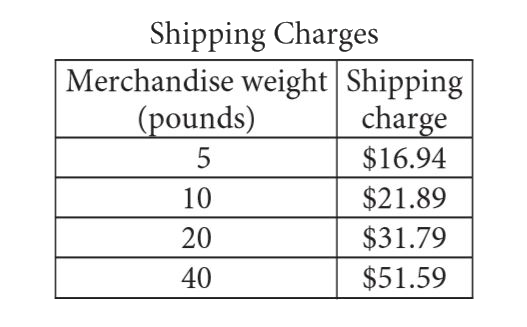
The table above shows shipping charges for an online retailer that sells sporting goods. There is a linear relationship between the shipping charge and the weight of the merchandise. Which function can be used to determine the total shipping charge f (x) , in dollars, for an order with a merchandise weight of x pounds?
f (x) = 0.99x
f (x) = 0.99x + 11.99
f (x) = 3.39x
f (x) = 3.39x + 16.94
The correct Answer is:B
Since the relationship between the merchandise weight x and the shipping charge f (x ) is linear, a function in the form f (x ) = mx + b, where m and b are constants, can be used. In this situation, the constant m represents the additional shipping charge, in dollars, for each additional pound of merchandise shipped, and the constant b represents a one-time charge, in dollars, for shipping any weight, in pounds, of merchandise. Using any two pairs of values from the table, such as (10, 21.89) and (20, 31.79), and dividing the difference in the charges by the difference in the weights gives the value of m: m=31.79−21.8920−10 , which simplifies to 9.910 or , 0.99. Substituting the value of m and any pair of values from the table, such as (10, 21.89), for x and f (x ), respectively, gives the value of b: 21.89 = 0.99(10) + b, or b = 11.99. Therefore, the function f (x ) = 0.99x + 11.99 can be used to determine the total shipping charge f (x ), in dollars, for an order with a merchandise weight of x pounds.
Choices A, C, and D are incorrect. If any pair of values from the table is substituted for x and f (x ), respectively, in these functions, the result is false. For example, substituting 10 for x and 21.89 for f (x ) in f (x ) = 0.99x yields 21.89 = 0.99(10), or 21.89 = 9.9, which is false. Similarly, substituting the values (10, 21.89) for x and f (x ) into the functions in choices C and D results in 21.89 = 33.9 and 21.89 = 50.84, respectively. Both are false.
Similar Questions
The inequation that best describes the graph given below is _________
02:17View SolutionThe inequation that best describes the following graph is _________
02:10View SolutionWhich inequations represent the shaded region in the given figure
04:23View SolutionIn Fig, find the value of x.
ltimg src="https://d10lpgp6xz60nq.cloudfront.net/physics_images/PS_MATH_IX_C12_S01_032_Q01.png" width="80%"gt01:13View SolutionAt x=0, value of (dy)/(dx) is : ltimg src="https://d10lpgp6xz60nq.cloudfront.net/physics_images/ALN_PHY_R04_E01_024_Q01.png" width="80%"gt
01:50View SolutionThe total surface area of the given solid figure is _______________.
 01:52View Solution
01:52View SolutionAt x=0, value of dydx is :
ltimg src="https://d10lpgp6xz60nq.cloudfront.net/physics_images/ALN_PHY_R04_E01_024_Q01.png" width="80%"gt02:34View Solution

